Translated by Nick R
When creating our gardens, we often ask ourselves some questions such as, what style do we want it to have? what would it look better for the space we have? or what would be the best garden for the area we live in?
Well, in other posts we’ve already talked about 2 types of gardens that can be very beautiful and adapt very well to our needs; namely, the vertical gardens and the Xero-gardens.
In this blog, I want to show you another type of outdoor garden that will provide a magnificent view of your home. This is the rock garden that, as its name suggests, is made of rocks.
However, rockeries are more than just a couple of rocks and one or two plants. It’s worth following a few recommendations before creating a rockery garden.
Next, I’ll tell you what a rock garden is, the necessary conditions and care, and give you a list of plants ideal for this type of garden.
Table of Contents
What is a rock garden?
Rock gardens are landscapes made of rocks and consist of planting alpine plants whose growth is contained, that is, they don’t grow much. This type of garden seeks to replicate the alpine habitat in which these plants grow.
This type of garden has been considered one of the most interesting and stimulating in the gardening world. And what most characterizes the rock garden is that they do not require large spaces or very extreme specifications, you can have one in the place you want.
Thus, the ideal plants for this garden are the alpines, which means plants native to the Alps or high mountains. These plants adapt perfectly to the rockeries and the reduced spaces of this garden, for they have a compact size.
Another characteristic of the rock garden is, as I mentioned at the beginning, that it opens up the possibility of creating a natural habitat on a smaller scale, isn’t it incredible? Besides, rock garden plant species are very vivid and have intense colors and diverse aromas.
Rock gardens originated in England thanks to the interest in growing exotic species and the development of mountaineering. As the contact with the alpine regions grew, so did the fascination for these rockery plants.
It all started with the cultivation of these plant species in pots and greenhouses, but then rockery settings that would mimic the natural habitat began to be created. These gardens spread throughout America, and as a result, other varieties of plants, not necessarily alpines, are now being planted.
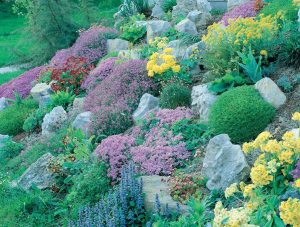
Requirements for having a rockery garden
As I mentioned before, this type of garden doesn’t have a lot of demands, for example, it doesn’t require large spaces. However, you need to carefully plan the location of your garden, the type of stone to use, and how to adapt the soil.
Location
In order to locate your rock garden in a suitable space and get great results, it’s essential to know beforehand the rock garden plants’ needs.
Several of these species don’t tolerate soil with high humidity. For this reason, try to avoid setting up your rock garden in swampy, waterlogged, or shady areas, or close to hedges or shrubs.
If you want to have alpine plants in your rock garden, be aware that they are very sensitive to high humidity.
For this reason, it’s recommended that, for these species, you place the garden in an area with adequate drainage, plenty of sun exposure, and that is open and well ventilated.
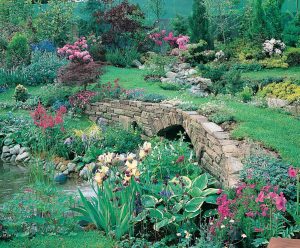
There are places with natural rock structures that you can use for your garden, this will make it look less artificial yet very pleasant. However, although these spaces are already suitable, they can be affected.
Natural settings can suffer from soil dehydration, depletion of water reserves, and even weeds. But don’t worry, later I’ll explain what aspects you should keep in mind to care for your garden and avoid any of these issues.
Selection of the stone
A great tip for choosing the right stones to make up your garden is to choose local ones. That’s because local stones harmonize with their surroundings and are much cheaper to get.
To make the aesthetics of your garden look stunning, you can use rocks with various dimensions. Since they’re partially buried into the ground, they create the effect of a rocky outcrop, as if they were rising out of the ground.
There are smooth stones, such as:
- Basalt
- Granite
- Porphyry
- Slate
And porous stones, such as:
- Tuff
- Limestone
The first group is better suited for these gardens due to its smooth surface, which is free of moss and more resistant to atmospheric conditions.
Unlike smooth stones, porous stones are lighter and can retain moisture. You can drill them to contain plants inside; tuff lends itself well for that.
However, these rocks can form moss on the surface and become fragile over time. To use these rocks, you should buy them in dry seasons because they are sometimes sold by weight and since they can hold lots of water, their value could be influenced by this.
To make your garden look stylish with porous rocks, you don’t need to use several types of stones; it’ll be enough to use them in different sizes.
Preparation of the land
Although rockery plants are adapted to this environment as it is their natural habitat, you shouldn’t think that it’s just a matter of placing a couple of rocks and plants randomly. You need to prepare the soil properly before starting to create the garden.
First of all:
You’ll have to do several interventions during the construction of the garden. This way you can ensure that the substrate is well distributed among the rocks. Once installed you won’t be able to make modifications, so bear in mind the above.
Secondly:
You must keep in mind the plants you’re going to plant because they need significant amounts of substrate. This substrate will settle in every part of the stones, including the gaps (the small spaces between the stones), so it must be a modest amount.
Otherwise, the plant wouldn’t receive the necessary nutrients and would have water deficiency. As you know, plants absorb what they need from the substrate through their roots, and if they don’t have enough, they could be harmed.
Third and last:
It’s necessary to take preventive measures against weeds, as they are fearsome enemies for rock gardens. Because of the distribution of the rocks and their nature, it’s very difficult to remove these weeds so you must make sure there is nothing that benefits their propagation, such as seeds or rhizome fragments (subway stems of the plant).
For this garden, you must be aware of the soil or land on which it will be built, because it must be well structured and ensure water drainage. So, if this second condition is not being fulfilled, you can add some sand or gravel.
Also, you must consider the soil or ground on which you’re going to build it because it must be well structured and ensure water drainage. So, if this second condition is not being fulfilled, you can add some sand or gravel.
You can test whether the problem is solved or not by digging a hole at least 30 cm deep and filling the hole with water. After 1 hour, the soil should be able to absorb and drain the water completely.
If, for example, the soil in which the rock garden will be placed is too soft and doesn’t retain the necessary water well, you’ll have to provide organic matter: either peat or compost.
On the other hand, the proper substrate for rock garden plants should contain peat, compost, sand, fine gravel, and soil from the area where you will place the garden. In addition, the pH of the soil needs to be adequate, since, for example, some species require an acidic one.
How to build a rock garden?
We can find alternative ways to build a rock garden besides the traditional rock garden construction. Below, I’ll share with you some of them.
Traditional rock garden
Traditional rock gardens are made in open places, either on slopes or on flat land. For this type of garden, it’s recommended to have a surface of at least 80 to 100 m2. This way, you’ll have enough space to maintain and enjoy the garden.
You may even choose the style that best suits your likes and the place you have destined for your rockery. Don’t forget in their natural habitat, rockeries grow out of the ground, so you may recreate that same landscape.

You can fashion a sort of terrace with large blocks of rocks where the ground is too unlevel. They will go in the contour lines (the little mountains or slopes that form in the ground); to create these curves, you must have a guide or plan so that the process is orderly and satisfying.
Mark the area where you want to have the contour lines with posts and strings before placing the stones. Bury the posts in the direction or height you want and tie strings to them to form a path. The ropes will be tied at the height at which the curve will be installed.
If the terrain is flat, you won’t need to mark contour lines since the terrain is leveled. What you can do is place the rocks in such a way that they simulate a slope. The rockery will look much more natural this way.
To start building, you must separate the rocks into two groups: small and large rocks. First, you must place or bury the large rocks to set up the garden structure. Depending on the shape you want to create, you’ll lay the rocks in the ground.
Then, place the smaller rocks to create the spaces, cavities, or crevices necessary to house the plants. Once the rocks are ready, add the substrate in those cavities, sow the plants and cover with mulch.
Stone walls and raised flower beds
Rock garden plants work more than well for stone walls. It’s a structure that can be a bit costly and is not built often, but there is always the option to do one.
For this structure, you must choose very rustic plants with the ability to withstand drought. And to give it a very striking aesthetic look, you can include hanging or cascading species.
When using non-porous stones for the wall, you need to add a substrate rich in clay and organic matter in the crevices before sowing the plants, so that the rocks will be able to retain enough water.
For those cases in which you have small spaces, you can build raised beds; divisions of soil that are placed in rows, and work very well to harmonize paved surfaces.
How is it done? You can use stakes and ropes for a square or rectangular bed or a hose if you want a curved one, to delimit the area where the bed will be placed. Then clean the soil thoroughly so no weeds can grow and proceed to arrange the rocks.
Use a crowbar or a hydraulic lift to move the rocks if they are large or heavy. At the bottom, place the wider stones and lay the others in tiers so they overlap one on top of the other.
For extra security, you can use a mesh to cover the entire wall. This is a sort of box or basket system, known as gabions, made of wicker or metal (stainless steel or galvanized iron).
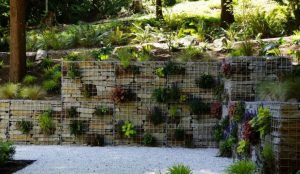
In case the wall is wide or has big gaps, you can insert linking stones between them to reinforce the wall. In the same way, add the substrate into the crevices of the beds to grow the plants.
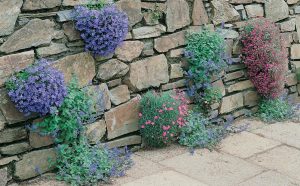

Hollow stones, pylons, and others
Most likely, you don’t have the space or the structures to create a rockery wall or a traditional rockery. But don’t worry, it’s possible to create this type of garden in containers. They are called miniature rock gardens.
The most suitable container for rock gardens is a hollowed-out stone, which needs to have draining holes at the bottom to allow water flow.
These containers get very heavy when full of soil, so you should place them in their final location while still empty. It’s prudent not to lay them on the ground, but in an elevated position using water-resistant supports, so that the drained water doesn’t stagnate.
The containers should have a height of approximately 25 cm (10 in.) because, underneath them, silt or mud can accumulate. Silt is produced by substrate particles that are carried away by the water through the drainage holes.
For miniature rockeries, you can use plants that don’t become invasive and have as well, different colors and flowering periods. In the borders, you can plant creeping plants such as primroses.
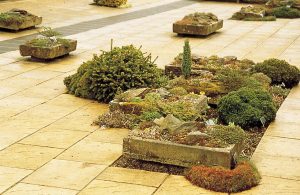
Care of the rock garden
In order to keep your rock garden in optimal conditions, you must dedicate time and attention to it. And to do so, you must know what care this garden needs, so you’ll feel confident in determining how much time you can devote to it.
Let me tell you once again, that most of the plant species that are used for rock gardens don’t require extreme care. As they have been forced to adapt into reduced environments, they have compact sizes that allow them to be tidy and not very invasive.
However, it’s worth knowing how to take care of your plants and the structure of the rock garden.
Watering
Some of the species of plants that are planted in rockeries are rustic and undemanding, however, that doesn’t mean that you shouldn’t water or care for them. Obviously, don’t exceed the watering limit, because remember that rock garden plants don’t like waterlogging.
In their natural habitat, alpine plants, for example, may have periods of little rainfall, but the morning dew provides them with a source of water to remain stable.
In the case of your garden, these environmental factors can vary so it’s better to control irrigation rather than letting it happen on its own.
So you have the possibility, in general, and taking into account the area and the time of year, to water every 10 days or implement an irrigation system (the latter is advisable for large rock gardens).
You must make sure that the substrate is evenly moistened and watering is abundant, but without puddling.
Mulching
Mulching serves to reduce water loss through evaporation, weed infestation, and harshness in the soil due to heavy rainfall. Several materials can be used to create a suitable mulch.
For rockeries, you can use natural gravels of various colors and sizes, which will give a nice and natural look to the garden.
You should periodically renew the mulch layer, as insects, birds, and rains cause the mulch materials to interfere with the substrate, and this will cause the substrate to become impoverished and sink.
The best time to mulch is in spring, before the vegetative restart, namely when the plants start to grow again after the resting period. At the beginning of this period, weeding and fertilization also take place so you must carry out a couple of actions before these processes occur.
The first consists of removing the superficial substrate layer that is loose, disordered, exhausted and degraded. The second action is to renew this layer of substrate for a fresh one to prevent it from getting poorer and affecting the plants. Finally, the last action consists of adding mulch.
You can choose gravel with different granulometry as there are several granule sizes for this material so that the garden looks more attractive and has a natural appearance. Keep in mind that if you have acidophilic plant species, i.e. plants that require acidic soils, you should not use calcareous sands and gravels, which contain calcium. These cause an increase in the pH of the soil and these plants don’t tolerate alkaline soils.
Weeding
Even with mulching, which protects rock gardens quite well, and the other tips I’ve given you, there is still the possibility that the garden suffers from weed invasions.
For this reason, it’s vital that you constantly check your garden to make sure that these pesky weeds are not thriving. If they do appear, you should remove them immediately so that the situation doesn’t get out of hand.
You can use herbicides to prevent the appearance of weeds; however, some plant species are very sensitive to these substances, and you’ll need to deal with them manually if you don’t want to harm your plants.
The use of herbicides is recommended in large gardens, but experience and care are important when applying the product. You can apply herbicides during the building of the rockery and during maintenance, however, these are not miraculous solutions.
I advise you to use herbicides only if necessary and as a last resource. It’s better to maintain previous care and precautions before resorting to more drastic measures.
Take weeding as a distraction, an activity to get to know your plants and share with nature; it doesn’t have to be a burdensome job.
Fertilization
Although rockery plants are rustic, they require a soil with the right nutrients to thrive. If the soil is optimally fertilized and the substrate is well balanced, there will be no need to fertilize over several seasons.
It’s also vital not to oversaturate the soil with fertilizer, for some plants don’t react well to it. They may over-vegetate, delay flowering or reduce root development.
You can mix, in small quantities, organic fertilizer with the substrate that you renew in the spring season. If you prefer to use mineral fertilizers, apply them every 2 or 3 growing seasons.
The proportions of NPK fertilizer (nitrogen, phosphorus and potassium) should be the same; a dose of 50 g of fertilizer per m2 is enough. You can use slow-release fertilizers as they supply nutrients progressively.
As I mentioned before, fertilizers can be applied in early spring, before the rockery resumes vegetation.
Pruning
It’s imperative to remove those parts of the plants that are wilted or dry after flowering. You can prune to maintain the aesthetics of the garden, which will help the plants stay vigorous and long-lasting.
Clearly, you must be familiar with the plant species to know exactly when and how to prune, so you must first inform yourself of all the needs and requirements of these plants.
For example, plants belonging to the genus Aubrieta and Arabis benefit from a spring pruning just after flowering. This way the plant can develop new buds and have a compact shape.
Pests
Rock gardens don’t suffer too much from diseases or pests, although this doesn’t mean that they won’t be affected at some point. You just need to keep the necessary precautions so that the plants don’t get infected by pests.
Fungal diseases such as gray mold (Botrytis) should be treated with fungicides if they become too extreme. Botrytis breaks out on the leaves and can cause mildew spots, besides, it develops more easily in humid and poorly ventilated environments.
Before using any chemical product to eliminate these diseases, you can carry out a few precautions. The first thing is having good hygiene in the rockery, the second is to remove the affected parts of the plant and the third is to do the respective pruning.
An additional recommendation is, in case you prefer to buy the plants, to select a reliable nursery that takes the necessary care and precautions with the plants. This way you won’t have to deal with annoying pests from the beginning, and in case they appear later, you can use insecticides to eliminate them.
Characteristics of rock garden plants
Now that we talked about how to build and maintain a rock garden, I’ll explain how to plant and care for this garden, as well as some recommendations of species for you to start creating your rock garden.
Growing the plants
You may prefer growing your plants from scratch rather than buying them from others. In that case, you can follow some procedures that I’ll share next.
Growing rockery plants from seeds
Several rockery species can be reproduced by using seeds. In markets, you can find seeds that have been sieved and selected, which is done to obtain pure seeds with high germination potential.
In case the seeds you’re sowing are going through a period of vegetative dormancy (i.e. they are in a resting stage in which they won’t germinate), you’ll have to cultivate them at the beginning of the winter. The dormancy period can vary by species, but is determined by environmental conditions and can be only determined by trial and error or by finding information about the seed.
You’re going to place these seeds in a cool, sheltered place so you can have plants in the spring. For sowing, you can use plastic containers with a fine, lightly fertilized substrate.
The substrate you use should not puddle so that the seeds don’t grow mildew while retaining the necessary humidity. The substrate should be loose so that the roots can flourish and the plant can sprout.
You can use low-fiber peat and mix it with perlite or vermiculite. If you don’t have a greenhouse, you can cover the seeds with plastic wrap so that moisture is not lost. Keep them at a temperature of 12 to 20 °C (50 to 68 °F), and transplant them once they sprout their first leaves.
Then, put them in another container until they develop further enough to sow them in the rockery.
Growing rockery plants from cuttings
Rockery plants can also be reproduced by cuttings, that is, a part or portion obtained from the mother plant. One advantage of cuttings is that they grow with the characteristics of the mother plant.
Cuttings can be herbaceous, semi-woody, woody, leafy and root cuttings. In our blog about cuttings, we explain in detail everything you need to know about them. The type of cutting to take depends on the species of plant you want to reproduce.
Herbaceous and semi-woody cuttings are usually used for rockery plants. It’s possible to take portions of the mother plant after pruning. In this case it’s advisable to keep the cuttings in polyethylene bags until the sowing time comes.
You can use hormones to promote the cuttings rooting and plant them in a similar substrate to that of the seeds. We’re talking about low fiber peat mixed with sand, perlite or vermiculite.
As the cutting produces roots it’s prone to dehydration so you’ll need to increase the humidity for the leaves to absorb the water. You’ll only need to cover the cutting with plastic wrap, the same as with the seeds. You can create a home greenhouse for this purpose, without condensation.
To reproduce rockery plants by cuttings, you can do it in spring and summer. On the other hand, reproduction of foliar cuttings (i.e., by leaves) is possible for some species such as Sedum spp, a genus of succulent plants.
You can also take root cuttings from species belonging to the genera Anemone, Erodium, Gaillardia, Papaver, and Pulsatilla.
Growing rockery plants by division
Some species of rockery plants, like Achillea atrata (Black Yarrow), can be reproduced by plant division. This consists of taking shoots with sprouts and roots and planting them individually to grow as a new plant.
Plants propagated by this method take a long time to develop before being transplanted into the rock garden. They turn out to be a bit more sensitive to cold and drought than the mother plant.
Planting of rockery garden plants
As you may have noticed, regardless the method you use, before planting the plants in the rockery they must first develop in pots. When ready, take them out of the pot and you’ll notice that their roots grow in a spiral.
Remove a little of the adhered substrate without damaging the roots, so that the roots can stretch a little in the rockery and have it easier to develop in the new substrate.
When you’re about to sow the plants, make sure that there are no gaps between the stones, all the spaces must be well filled with substrate. The plant roots need to be firmly buried in the substrate. For that, remove a little of the substrate, sow the plants and reinsert the soil and press down on the root collar to strengthen the roots.
The best time to plant is in the cooler hours of the day, at that time the rocks don’t give off too much heat and the sunlight is not so intense. A few days after sowing the plants monitor the humidity of the soil, which favors the establishment of the plants.
If you use porous stones for the rockery, you’ll have to sow the plants in autumn so that they don’t absorb water from the substrate, which harms the plants. For rock walls, there is no need to dig the root collar too deep into the substrate.
Use suitable spaces that hold the substrate adequately and are not likely to empty easily.
List of ideal plants for the rock garden
Now that you know a little more about rockeries or rock gardens and everything you must take into account to make one, I’ll provide you with a list of some of the plant genera that you can have in these gardens.
| Género | Descripción |
Ajuga  | It’s a genus consisting of small plants with thick foliage and climbing behavior. Some plants have a particular color in their foliage and turn out to be very showy. The color of their flowers is usually blue and the plants function as tapestry. They can be reproduced by seed or by plant division. Besides, they require exposure to direct sun, can tolerate shade or semi-shade, and are very easy to grow. |
Anemone  | This genus includes plants that are adapted to understories, making them suitable for partially shaded rock gardens. Flowering occurs in spring and flowers have diverse colors. You can reproduce these plants by division or seeds. |
Bergenia  | Plants of this genus have broad leaves and bloom in spring. They can withstand shady locations or direct sun. Some species can be invasive and not recommended for a rock garden, but you can plant them alone in hollow stones. You can reproduce these plants by division. |
Dianthus  | This is one of the most suitable genera for rockeries. It has flowers of various colors such as red and white. Some species have hanging growth and can be reproduced by seeds or cuttings. They are plants that like direct sun exposure. |
Festuca  | This genus of plants is very striking thanks to the morphology of its foliage. They are bushy and have striking colors. You can reproduce these plants by division, and they tolerate shaded areas or direct sunlight. They are easy to grow. |
We’ve reached the end of this blog about rock gardens. As you may have realized, they are gorgeous gardens that you can have in your yard. It’s worth following the recommendations I mentioned so that your plants are not affected by any disturbance, and you’ll always have a beautiful garden.
In addition, in our blog about outdoor plants, you have a small list of gardens to inspire from. Do not wait any longer to get to work and create a spectacular rock garden. I’m sure you’ll love it, and it’ll be a great excuse to distract yourself a little bit from the day to day life.- Lighten up!


